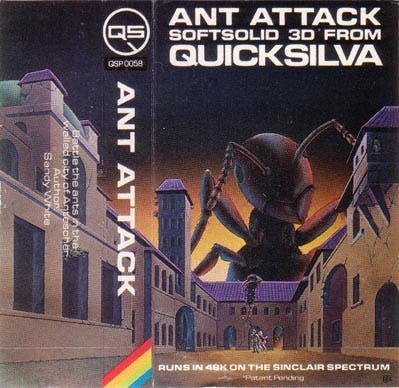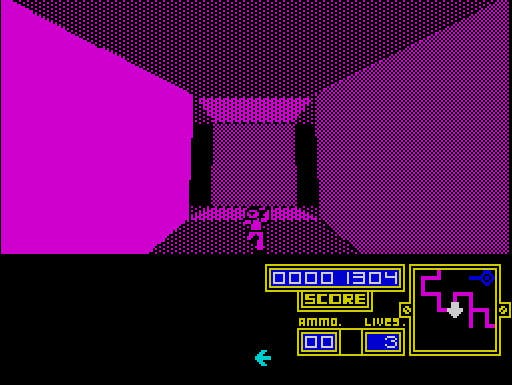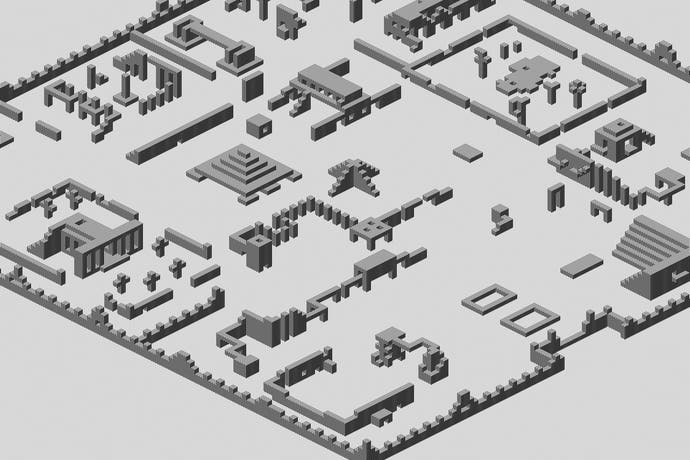Code Britannia: Sandy White
The creator of 3D pioneer Ant Attack on the importance of shapes, pansexual game characters and the indie revival.
Code Britannia is an ongoing series of interviews with seminal British games designers, looking back over their careers and the changing face of gaming.
One of the great things about being there for the start of a new creative medium is that it arrives as a completely blank canvas, where every idea can become the first of its kind. That was certainly true of the brief but brilliant games career of art school graduate Sandy White, who was creating persistent worlds on the ZX Spectrum using his SoftSolid 3D process while today's superstar designers were still in short trousers. Sandy is best known for Ant Attack, an astonishing work of eerie minimalist panic in which you guide your hero - or heroine - to rescue people from the insect-infested city of Antescher.
Arguably the first fully explorable solid 3D world in gaming, Antescher felt like a real place. You could rotate your view, disappear behind structures and navigate by recognisable landmarks. The city itself became a gameplay feature. Ant Attack remains a great game today, but by the standards of 1983, when it was first released, it was absolutely groundbreaking.
Sandy went on to create only two more games, both for the Spectrum, before retiring from the industry, but his legacy lives on in pretty much any open world game you care to mention - Minecraft's chunky blend of exploration and survival is very much built on Antescher's foundations.
It all began, however, with an interest in technology in general. "I'm a child of the Sixties," says White. "No iPod touch, no DS, not so much as a pocket calculator even. However, while the grown-ups were twisting about looking like Austin Powers and getting laid on rotating water beds, I was apparently crawling around dismantling my toys and chewing apart old zinc carbon batteries."
Somehow surviving this childhood diet of battery acid, White poured his obsession with how things worked into creating his own games. With home computers still a long way off, his early efforts were board games - or "bored games" as he called them at the time - but even when working with old cereal boxes as his canvas, he was quick to incorporate innovative features.

"One Saturday my dad took me to Woolworths and bought me some torch bulbs, batteries, wire and a switch and showed me how to wire them up. These things quickly got incorporated into my next board game, which had squares which lit up."
As the Seventies rolled around in a flurry of polyester, the popularity of computers was growing, though they were still a long way from being a home appliance. Undeterred, Sandy collected old relays thrown out by the local Post Office and tried assembling his own computer using a screwdriver and the family bread board. Eventually, an Acorn Atom found its way into the house and Sandy was able to start coding for real.
"The phenomenon of home gaming kind of crept up on me," he recalls. "I think it was my brother who saw what I was doing on the Atom and said 'You could write a game!' Even then, it was still just for fun, and I had no awareness of there being a games industry."
Very soon, he was tinkering with the isometric 3D graphics that would make his name. "When those first experiments in Atom BASIC started to look like weird random cities, it was like nothing I'd seen before, slightly spooky and unreal. Surprising even that I could wander about and come back to a place I had been before."
It's no surprise that it was surprising as, by accident, Sandy had become one of the pioneers of what we'd now call virtual reality. Clearly, there was commercial potential here that the Acorn Atom wasn't going to satisfy. By this point Sandy had graduated from cornflakes packets and breadboards and been to art school where he studied sculpture. Meanwhile, the home computer itself was evolving. Sandy's brother picked up a Spectrum, and it was this machine that became Sandy's platform of choice for his first ever game - Ant Attack.
Building Antescher was a slow and absorbing process, however, and its angular shapes imprinted themselves on his mind. "I think that anyone who has played in a virtual world will understand how the places can become real in a certain way, they get into your head and your dreams just like real places do," Sandy muses.
"I think that the effect was particularly potent when I was developing these first isometric buildings because it was an entirely new experience for me; home computers with graphical displays had barely arrived on the market. Relatively speaking, I suppose I was one of the first few people on the planet to build a 3D world and walk around inside it, and I did that for five months inside Antescher.
"I suppose I was one of the first few people on the planet to build a 3D world and walk around inside it."

"Perhaps I have a strange mind, but many of the buildings and places in that city still bring back feelings of the days when they were being constructed: the rainy weather, a memory of a song playing on the radio, the mood I was in, what was on the telly, or maybe a feeling of excitement about the technology itself."
In 1983 Ant Attack was picked up by a small UK publisher called Quicksilva, which had already scored a hit with Jeff Minter's Gridrunner. In these formative industry years, however, "publisher" was a relative term. "They were barely out of being a cottage industry duplicating tapes on someone's kitchen table," Sandy recalls.
The game immediately attracted plaudits from the nascent gaming press, earning an 85 per cent score in the first issue of seminal Speccy mag Crash. It would also be nominated for one of CVG's first Golden Joystick Awards, where it inexplicably lost out to wandering baby platform game Ah Diddums, an awards upset on a par with Forest Gump swiping Best Picture from The Shawshank Redemption and Pulp Fiction.
Ant Attack didn't just pioneer in terms of graphics. It became one of the first games to allow the player to choose their gender, allowing women to rescue men from the ravenous insects as well as the other way around. "Having just come out of art college at a time when sexual equality was a hot topic, it would have been unthinkable to do it any other way," explains Sandy, although it seems he wishes he'd gone further in exploring the whole Kinsey scale in digital form. "If I could have put in a gender setting which went all the way from male to female with everything in between, I would have."
Unlike other games - such as Ah Diddums, to pick an obvious example - the credibility of Ant Attack has only grown over the three decades since its release. In 2009, Edge declared that the game marked the beginning of the survival horror genre, an accolade that Sandy declares himself "delighted" to accept.
"My own thoughts about Ant Attack sometimes seem drowned out by other peoples, to the point where it is difficult even now answering your question," he says when I ask if he finds Antescher's legacy overwhelming. "I do remember whilst working on it, flickering in and out of feeling that it was something really special, and feeling that it wasn't. The bottom line is that Ant Attack is pretty much a product of its time, or if I'm lucky, a product of ever so slightly before its time. I'm a great nostalgist, so I am simply 'chuffed to a hairy weed' to be connected with a part of the history of gaming."
"My own thoughts about Ant Attack sometimes seem drowned out by other peoples."

With a critical and commercial hit on its hands, Quicksilva subtly hinted that a sequel might be a good idea. "I was definitely being encouraged to produce a follow-up to Ant Attack, though I seem to remember not being that interested. With hindsight I think having decided to do it, I should have done a traditional sequel - kept to the same basic plot, improved the controls, added more characters, added loads more levels and so on. For reasons which now elude me, that option at the time seemed to me rather like cheating, and I wanted to do something new."
That "something new" became the Romero-inspired Zombie Zombie, which once again featured an isometric city but now included a helicopter with which to fly around, and the ability to add or subtract blocks to change the terrain. Zombies could only be killed by luring them up to high places and letting them fall to their doom. Where Ant Attack's gameplay had developed organically around the environment, Zombie Zombie found Sandy trying to impose new gameplay ideas on top of the formula.
"Ironically, it fell flat on its face," White confesses. Zombie Zombie still impressed from a technical standpoint, but as a game it was too often fussy and overwhelming. "I had been inspired by the way the original Space Invaders arcade game got more difficult as you shot more aliens, behaviour which emerged simply because fewer invaders on the screen drew faster on the limited hardware, so the frame-rate went up. The same approach simply didn't work when switched from a simple arcade game to a 3D exploration title. "Sadly, in those days there was no internet to enable updates or changes after the event," Sandy adds.
Sandy abandoned the isometric cities for his third game, I of the Mask, and instead embraced the idea of 3D exploration from a more abstract perspective. With more than a nod to Kubrick's 2001, you played as an astronaut tasked with reassembling a vast robotic entity, broken into pieces. You did this by roaming the labyrinthine corridors inside its body, now rendered in slow but undeniably impressive solid 3D. For 1985, it was ridiculously ambitious and it seemed that for Sandy game development had become a way to tackle his own obsession with virtual 3D spaces.
"You're absolutely right," White admits. "It was an obsession, and sadly in the case of I of the Mask an obsession which totally eclipsed the playability of the game. Its fair to say that I was way more interested in the technology of generating the graphics than in the game itself at this point."
"I feel lucky to have done something in my life which has been remembered for three decades."

I of the Mask soon faded into obscurity, but its rendering process - "one of the trickiest things I've ever written" according to White - provided the last essential stepping stone from the flat game worlds of old to the breadth and depth of spaces we take for granted today. "I remember being introduced to Incentive designer Ian Andrew at a trade show," Sandy reveals. "He told me, as I remember, that they had reverse engineered my code and based the Freescape engine on it. I was amused to find that they struggled to recruit programmers for the project, with many believing that it could not be achieved. Shame they never offered me a job, or a royalty come to that!"
I of the Mask was only Sandy's third game but it was also his last. His career as a games designer only lasted from 1983 to 1985, but that was enough for him. "The business as we know it today was in the process of discovering itself, and strangely enough even at the time I was writing I of the Mask, I was feeling isolated," he explains. "I stopped writing games because I was feeling pressured, miserable and bored."
Sandy walked away from the fledgling games industry and spent "a few years bouncing around the planet trying to figure out what to do". He eventually returned to computers as a freelance software engineer specialising in "soundscaping and mechatronics" but he remains very clearly invested in his gaming legacy, maintaining a special section of his website for fans of Ant Attack. Nor does he mind still being best remembered for something he created thirty years ago.
"I feel lucky to have done something in my life which has been remembered for three decades," he says. "I haven't spent as much time as I'd like on [the website], but since 2013 marks Ant Attack's 30th anniversary I've been making an effort and definitely plan to do something special before the year is out. I have an idea to post the original hand written source in full, for the curious, if I can get it into some kind of shape."
He's not ruling out a return to gaming either. "I never left games far behind, and am perpetually on the brink of doing something game related. I love the iPad as a platform, and I don't think the landscape has ever looked better for indies. Maybe I could pull together a small team, musician, artist, coder and make something interesting. My little creative heart leaps and dances an anty dance."


